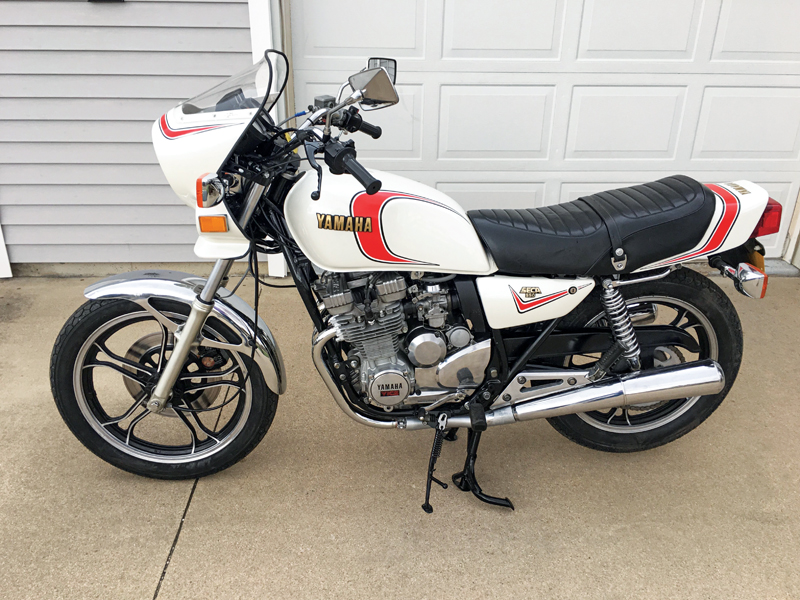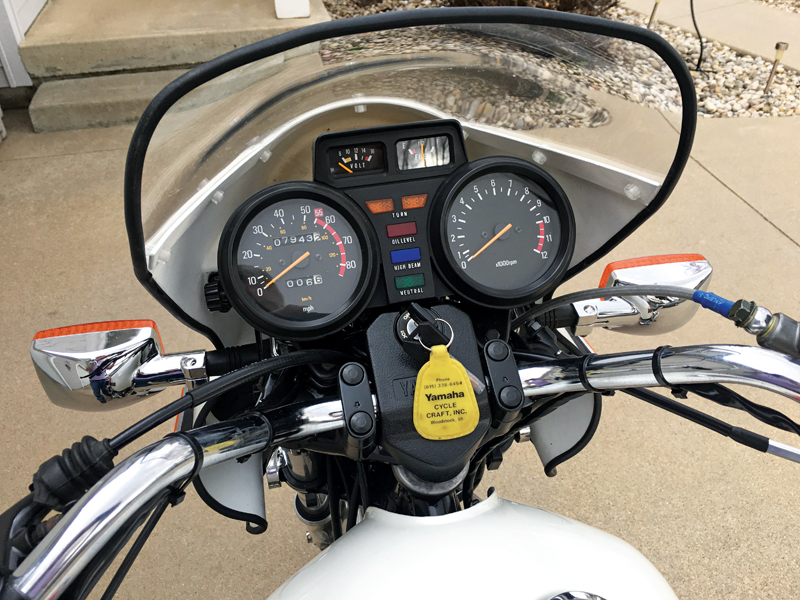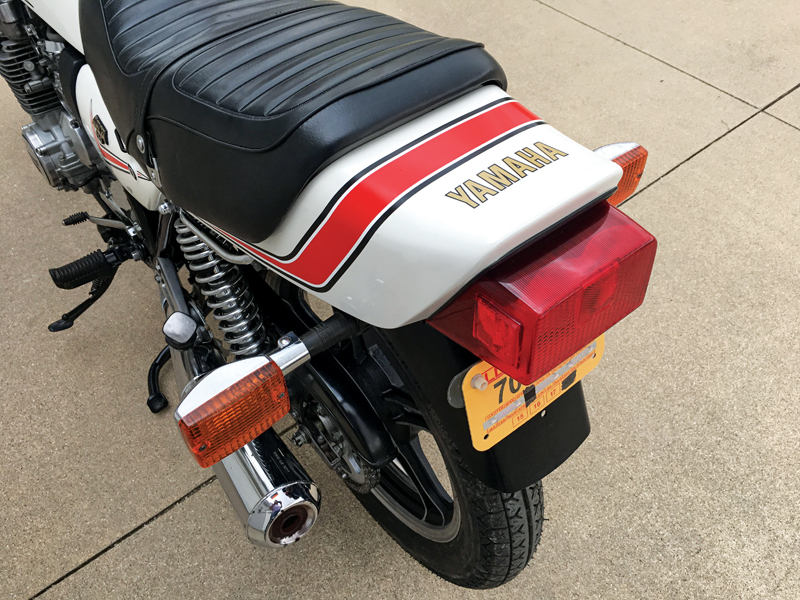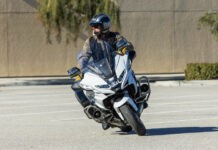
Two things a motorcycle manufacturer has to look out for when introducing a new model: the competition and the economy. Yamaha got the competition right when it introduced the XJ550 Seca in 1981, as mid-size bikes had not been very popular during the horsepower wars of the late 1970s. Honda had recently upsized its rather boring CB550 to the CB650, while Suzuki’s GS550E had been around for quite a while. Newish but not dazzling was Kawasaki’s KZ550, which was soon slightly hotted up, with problems, for the GPZ550 version.
While this new Yamaha was the cat’s pajamas…to use a 100-year-old phrase that means it is doing what it is supposed to do extremely well. The engine had been around a while, with all problems sorted out, an in-line four with two shim-adjusted valves per cylinder and two chain-driven overhead camshafts. One tricky bit was this new YCIS — or Yamaha Induction Control System — a rather complicated addition to the cylinder heads that was intended to improve combustion and also mileage. The main fuel intake would move along calmly and rapidly between carburetor and combustion chamber, until it met the YICS just above the valve. These sub-intake ports were all connected and would send fuel remaining in the other intakes into the carb’s cloud of fuel at a very fast rate, improving the firing chamber swirl. The better-burning also meant better mileage, and Yamaha was getting more than 50 mpg with the 550.

But we’re ahead of ourselves. Gas came down from the 4.2-gallon tank, mixed with air in the four 28mm Mikuni carbs, got sucked into the cylinders, compressed 9.5 times, with the magnetically triggered transistorized ignition, meaning no points, producing a spark at the appropriate micro-moment. Rapid burn! Exhaust gases pushed out to a header pipe, with the four headers running into two mufflers. Measuring the power we find this slightly oversquare 528cc engine created 50-plus ponies at 10,000 rpm, and a respectable 30 lb-ft of torque at a more modest 7,500 rpm. And if you had a really skillful rider at the bars, that bike could do the quarter-mile in just, very just, under 13 seconds and exceed 100 mph. Not quite what the average rider was capable of, but nice for boasting.
So how did the power get from the crankshaft to the rear wheel? A Hy-Vo chain from the middle of the crank ran to the jackshaft, with hydraulic tensioning keeping the chain in the best of condition. The clutch was wet, running to a conventional six-speed transmission, and on to a No. 530 chain going to the five-spoke (10 spoke if you’re fussy in your counting) cast wheel, protected by a 100/90 18-inch tire. Rear brake was a rod-operated seven-inch drum. A pair of preload-adjustable shocks offered a little bit less than four inches of travel, and were often changed for superior aftermarket units.
This was one narrow engine, with the alternator having been placed on top of the tranny rather than off to the side, as skinny is very useful for cornering. The engine was rubber mounted in order to keep the minimal vibes away. The steel tube frame was the full cradle variety, with a pair of downtubes coming from the steering head. Here, the non-adjustable front fork was also attached angling at 27 degrees, trailing 4.3 inches, and having 5.3 inches of travel. The 90/90 19-inch tire was well suited for handling just about any type of pavement. A single 11.7-inch disc with a single-piston caliper slowed things down, with a second disc being available and advised if the rider liked to go to a racetrack and do laps, which was becoming popular in the early 1980s.

Seat was long and flat, with the height at 31.5 inches, but was not praised by all. Bars were raised enough to be comfortable on an all-day ride, and the little headlight fairing and windshield kept the wind off. But not the rain. Sidestand and centerstand were both bolted on, making chain adjustment easy. Paper air filter was easily changed, and the battery quite accessible.
The dash was useful, with conventional speedo and tach, a couple of gauges to measure fuel and voltage, and standard idiot lights. The fuel gauge could be overly cautious in its indicating of how much fuel remained, but the bike was definitely good for 200 miles. Of note was the oil light indicating low level, rather than low pressure, which Yamaha felt was more important when preserving the engine was the concern. Light goes on, add oil.
The main complaint was the lack of adjustability in the suspension, both front and back. However, the bike was built down to a price, which was a little more than $2,500 in 1981. Plus, tax. Which brings us to what was mentioned in that first sentence, the economy. The Reagan-era recession resulted in a lot of unemployed, and citizens were focusing on essentials, like food and toilet paper, rather than expensive playthings. The recession caused the whole U.S. motorcycle business to take a hit, and companies contracted. In 1981 the Yamaha brochures showed 17 499cc and larger road bikes on the market; three years later, 1984, the number was down to seven.

Also, the other Japanese companies were improving their mid-range motorcycles, with a greatly improved 1983 Kawasaki GPZ550. And Honda’s new 550 Nighthawk looked good. Competition and recession? The last 550 Seca was the ’83 model, with a few unsold ones still on the market in 1984.
The 550 Seca was a very good motorcycle…in 1981. Two years later new bikes from the other OEMs made it look a bit on the old side. That’s the way a competitive economy works.
Retrospective: 1981-1983 Yamaha XJ550 Seca Photo Gallery:

Photos by Terry South. 










I had the 1982 version. Loved that bike but it was a bit “peaky” for a newbie like me. In 1983, it lost the headlight cowling and didn’t look as good to my eye.
I had a 1982 also, it was my first street bike. Mine was red, I think the white looks better. Rode it from LA to Vegas a couple times, and discovered the motor would burn oil on longer runs. fortunately found that before anything went south. On my normal 25-mile commute it never used any oil.
The seat was not awesome, good for maybe an hour or so. Later I had a 750 Seca, its seat was no better.
I was fortunate to have two of Yamaha’s Seca series bikes, both 1981 XJ750RH models. One was bone stock, the other, which I still have to this day from its purchase in 1993 was upgraded with a Vance & Hines four-into-one pipe and rejetting by a factory Yamaha mechanic that had owned it. To this day, the antidive front suspension works well, the LED array in the instrument pod works, and best of all, that DOHC four-stroke mill still works! One of the best handling bikes from the eighties I’ve ever owned, that old Seca is still a rush to ride.
Good to read such an informative account of xj550. I bought a minter a few years ago only 10 k on clock with four into one exhaust. It’s a great ride, love it, quite easy to maintain too, it might become a classic rarity. Surging powerband between 6 and 10 thousand revs and is quite happy cruise between 70 / 80 mph goes a lot faster when needed though I get a battering fro the wind as there’s no cockpit fairing, I prefer it’s looks this way. Has a reluctance to start if left for a while but I’m putting that down to fuel deterioration in carbs as with patience it will burst into life after a few spaced out attempts on pressing electric start. Definitely one to keep in the collection🙂
Worked at a Yamaha shop late 70’s to early 80’s. We had a white 81 as a shop bike. First bike I ever took over 100mph on. Holds a special place in my heart.
Yep I had an 81 wish I had it back but when I got to 90 miles an hour I would shake his head pretty bad
Hi Clement I enjoyed your wonderful story on your 1981 Yamaha SECA 550 .I currently have one also that I have owned for the last 8 years which I enjoy immensely. Wonderful bike ! It’s always fun to talk to someone who has the same interest in this bike . Can you email me Mustang06@msn.com and I will send you my phone number so we can have a conversation about this bike . Thanks Marie
Thanks for the trip down Memory Lane. I owned one, sold it and bought it back from someone else several years later. Still have it. We’re both slowing down, but still mostly running.
Bought one of these back in mid ‘84, loved the bikes handling and balance, way beyond anything I had ridden prior, got my best friends dad to drill and tap air fittings into the top fork plugs, connected with a Schrader valve. Several psi helped firm the forks, a set of Koni rear shocks were way better than the stockers, but the bike still would weave in high speed corners no doubt due to the flimsy tubular swing arm and cut price plastic swingarm bushes Yamaha used at the time. Brings back very fond memories.
Hi my name is I have a 82seca I am interested in who putair Vavles in and more info on back shocks could u help me out please thank you I would like to talk with them
first saw a 1981 at my work in the employee parking lot. that pearl white paint job took my breath away. being a kid in my 20’s thought i thought i could never afford a new bike. a couple of years later, the local Yamaha dealer advertised year-old, new 1982’s for $2,000 out the door. (remember the bike glut of the 1980’s, where all the Japaneses manufactures offered big discounts on left-over models?) $600 down, and a $100 a month, and i was the proud owner of a red 1982 seca 550. 40 years, and 50,000 miles later, i still have it. (and the engine has never been apart). other than batteries, tires, chains, fork rebuilds, a couple of starters, (and carb re-builds due to sitting too long), still runs great. they really did make a excellent sport bike, sure wish the seat was more comfortable though. today, the styling now looks a little “funky” (i think due to the fairing). but it is a very well balanced middle weight sport bike, with a 110 mph top speed (go ahead, ask me how i know). first, and probably last bike i will ever buy brand new.
My first bike was a 1982 XJ550 Seca, bought it new from the dealer in 1985 for $1,495. They had a bunch of them still available. It was fast compared to 1980’s cars but slow compared to the newer bikes. Well into my 20’s when the bike was 15 years old I had the thing so clean that people would ask me if I just bought it. It definitely aged well. Nearly 40 years later and I still have the ol’ girl and she is still turning heads.
Hi .my name is Tim I have an 82 the red with silver decals dam nice bike road fantastic .
I have gotten it painted a few years ago. No emblems thow or models insignias can’t find any . I also blew the head gasket on it , am hopping to get it on the road this summer . An yes it did turn heads alot . I really enjoyed that bike an miss it badly .
I have just purchased a 82seca like my other one . It has 39 thousand an is all original except the exhaust . Sweet right
I had one of the first ’81s – lovely bike for the street in it’s day, but the brakes left a lot to be desired on the track. I second disc certainly would have helped. Once the GPZ550 showed up it was over.
Hi all. My name is Darrell Melymick, and I live in Langley, British Columbia, Canada. I am in the process of restoring my ’82 Seca this winter (it has less than 30,000 Km., 18,640 miles on it). I’m looking for the following parts: stock windscreen for the small stock cowling; the right battery side cover; and a fuel-sending unit. I would greatly appreciate anybody contacting me regarding any of these parts. My email address is dmelymick@gmail.com, and phone no. is 604-513-9608. Thanks to you, in advance, for responding to this request. Cheers!